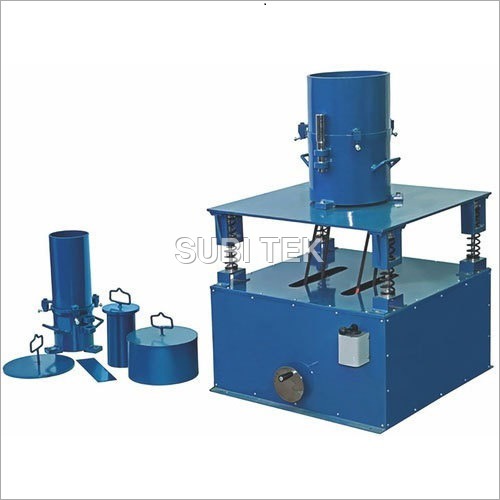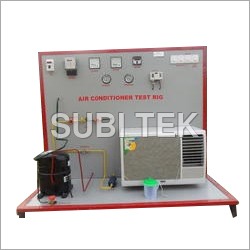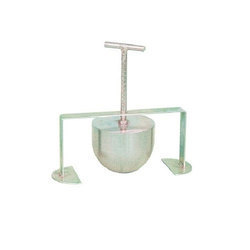Relative Density Apparatus
Relative Density Apparatus Specification
- Frequency
- 50 Hz
- Max Height
- 350 mm (approx. assembled)
- Temperature
- 10C to 40C (Operating)
- Display Type
- Analog / Graduated Scale
- Mounting Type
- Bench-top
- Response Time
- Instantaneous (Manual Reading)
- Power Supply
- 230 V AC, 50 Hz
- Resolution
- 0.01
- Automation Grade
- Manual
- Color
- Blue
- Port Size
- Standard size (as per model)
- Number of Specimens
- 1 or 2 (as per model)
- Accuracy
- 1% of reading
- Application
- Determination of relative density of granular soils
- Voltage
- 230 Volt (v)
- Measuring Range
- 0.5 to 2.5 (Relative Density)
- Equipment Type
- Relative Density Apparatus
- Material
- Metal
- Usage
- Laboratory
- Test Range
- 0.5-2.5 (Relative Density)
- Specimen Size
- Standard sample size (Typically 50-100 g soil)
- Features
- Corrosion-resistant metal construction, detachable parts for easy cleaning, robust design
- Product Type
- Apparatus
- Operating Voltage
- 230 V AC
- Humidity
- 0-95% RH (Non-condensing)
- Capacity
- Up to 1 liter
- Machine Weight
- 5 kg (approx.)
- Control Mode
- Manual
Relative Density Apparatus Trade Information
- Minimum Order Quantity
- 1 Piece
- Supply Ability
- Piece
- Delivery Time
- Days
- Main Export Market(s)
- Asia
- Main Domestic Market
- Uttar Pradesh, Punjab, Chandigarh, West Bengal, Andaman and Nicobar Islands, Pondicherry, Himachal Pradesh, Delhi, Karnataka, Dadra and Nagar Haveli, Meghalaya, Telangana, Madhya Pradesh, Maharashtra, Odisha, West India, Haryana, Gujarat, Daman and Diu, Arunachal Pradesh, South India, Andhra Pradesh, Nagaland, Assam, Kerala, Rajasthan, North India, Sikkim, Bihar, Jammu and Kashmir, Manipur, Goa, Tripura, Chhattisgarh, East India, Tamil Nadu, Mizoram, Uttarakhand, Central India, Lakshadweep, Jharkhand, All India
About Relative Density Apparatus
Our organization provides our clients a wide assortment of Relative Density Apparatus which is suitable for production of paper bag. Our expert professionals have created this is in various using the best quality raw material & advanced technology. It is used to determine the relative density of free-draining soils. Furthermore, we make available this Relative Density Apparatus available in different specifications so as to meet divergent demands of the customers. Purchasers can avail this machine at feasible rates.
Other Detail
Condition : New
Features:Durable, Corrosion Resistance
Delivery time Depend On Location
Dealer in Chennai
Manufacturer in Chennai
Robust Design and Construction
Crafted from heavy gauge steel and chrome-plated or stainless steel, the Relative Density Apparatus offers superior durability and corrosion resistance. Its bench-top mounting and compact size allow for convenient laboratory installation, while detachable components facilitate easy cleaning and maintenance.
Precise Measurement and Compliance
The apparatus measures relative density accurately within the range of 0.5 to 2.5, meeting IS: 2720 (Part XIV), ASTM D4254, and ASTM D4253 standards. The analog graduated scale displays readings with 0.01 resolution, supporting precise analysis and ensuring standard compliance for soil investigations.
Efficient and Safe Operation
Operated manually, the apparatus requires a standard 230 V AC, 50 Hz power supply. Its ergonomic accessories and box-packed delivery with protective cushioning support safe transport and handling. Designed for quick setup, it accommodates one or two specimens, conforming to standard soil sample sizes.
FAQs of Relative Density Apparatus:
Q: How is the Relative Density Apparatus used in laboratory settings?
A: The Relative Density Apparatus is used to determine the relative density of granular soils by following specified procedures outlined in IS: 2720 (Part XIV), ASTM D4254, or ASTM D4253. Soil specimens are placed in the glass cylinder, and accessories like the tamping rod and straight edge are utilized for sample preparation and measurement. The analog scale provides instantaneous readings during the manual operation.Q: What materials make up the jar and cylinder of the apparatus?
A: The jar is manufactured from heavy gauge steel with either chrome plating or stainless steel, ensuring enhanced durability and corrosion resistance. The glass cylinder has a standard capacity of 1 liter, but custom sizes are available to meet specific test requirements.Q: What standards does the Relative Density Apparatus comply with?
A: This apparatus adheres to IS: 2720 (Part XIV) and international ASTM standards D4254 and D4253, ensuring precise and standardized evaluation of soil relative density for laboratory research and construction quality control.Q: When should the Relative Density Apparatus be used?
A: The apparatus should be employed when assessing the maximum and minimum densities of granular soil specimens, especially during quality control tests in geotechnical laboratories and construction material analysis. Usage is recommended within 10C to 40C ambient temperature and 0-95% relative humidity (non-condensing).Q: Where is the apparatus typically installed and operated?
A: It is designed for bench-top mounting, making it suitable for laboratory environments in universities, research centers, and industrial testing facilities. Its box-packed format with protective cushioning ensures safe transport and installation across India.Q: What is the testing process with this apparatus?
A: Soil samples are weighed and prepared using the provided accessories, then placed into the glass cylinder. The operator manually adjusts the specimen as per the specified test protocol. Measurements are taken using the analog graduated scale, achieving 1% accuracy with a resolution of 0.01 in the relative density range of 0.5 to 2.5.Q: What are the main benefits of using this apparatus?
A: Key benefits include accurate, rapid measurements of granular soil density, compliance with stringent standards, robust construction for longevity, corrosion-resistant metal parts, and ease of cleaning through detachable components. Its manual control and compact design offer reliable laboratory performance and convenient handling.

Price:
- 50
- 100
- 200
- 250
- 500
- 1000+
More Products in Laboratory Testing Equipment Category
Window Air Conditioning Trainer Kit
Price 105000.00 INR / Piece
Minimum Order Quantity : 1 Piece
Color : white
Material : MS
Usage : Industrial
Power Supply : Electric
Kelley Ball Penetration Apparatus
Price 12000 INR
Minimum Order Quantity : 1 Piece
Color : White
Material : Mild Steel
Usage : Laboratory
Power Supply : Manual
Hand Operated Centrifuge Extractor
Price 12000 INR
Minimum Order Quantity : 1 Piece
Color : Blue
Material : Metal
Usage : Industrial
Proving Ring With Dial Gauge
Price 12000 INR
Minimum Order Quantity : 1 Piece
Color : Gray
Material : Steel
Usage : Laboratory
Power Supply : Manual
GST : 33AVTPM1866A3ZI
|
 |
SUBI TEK
All Rights Reserved.(Terms of Use) Developed and Managed by Infocom Network Private Limited. |


 Send Inquiry
Send Inquiry





